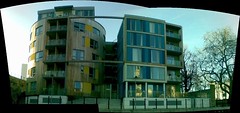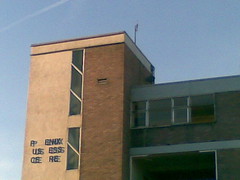A waterfront is as good as a skyline
 Isn't the weather just great at the moment! (Apologies for any insensitivity towards any readers from Bismarck, North Dakota). So great that I spent most of yesterday's daylight hours out of bed and out of doors, and intend on a repeat performance today, once the blog's finished.
Isn't the weather just great at the moment! (Apologies for any insensitivity towards any readers from Bismarck, North Dakota). So great that I spent most of yesterday's daylight hours out of bed and out of doors, and intend on a repeat performance today, once the blog's finished.
The morning involved seeing one of these, hearing one of these singing (always a good sign of spring) and nearly falling in the canal. In the afternoon I cycled along the canal to Limehouse with Tom for a couple of drinks on the waterfront, and where Beard also joined us later. Various sights along the canal:
I like this building, but I don't think it fits in London at all. Modern looking, interestingly shaped and textured apartment buildings can work in London, but this clean, pine boarded and pastel panelled construction looks awkward in grimy Poplar. Charles keeps going on about traditional styles, and building modern structures in appropriate settings and, it turns out, I agree. I just think people focus too much on the size of buildings, and assume big ones are going to be eyesores.
The Phoenix Business Centre, which is struggling - to say the least - to rise from its East London ashes.

Some interesting shadow effects on the water.
New flats going up in Bow/Stratford, near the olympic park.
Now - on to the main point if this post. There is much talk about preserving London's historic skyline. These energies would, I feel, be much better spent campaigning for the reinstatement of a public Thames waterfront.The Morpeth, near where I work, has numerous prints of old London scenes. One that caught my eye the other day was of Somerset House before Victoria embankment was built (similar to the picture to the right). It shows a public courtyard with steps leading down to the river.
As this article explains:
"London's roads were becoming increasingly congested and its sewers unable to cope ... The Embankment was intended to carry a new road along the edge of the Thames from Westminster to the City of London and, below ground, to accommodate large sewers and a line for the Metropolitan and District Railway.
The introduction of the Embankment had the effect of distancing the river from the buildings along its north bank, particularly significant for Somerset House, which had been designed to rise directly from the water ... The dramatic waterfront design of Sir William Chambers' Somerset House had effectively been destroyed a little more than a decade since the building of the New Wing had seen its completion."
 Somerset House is a particularly striking example of how there are very few places away from the South Bank where one can sit by the river. Limehouse is one of the very few. Unfortunately the view from there is blighted by the many cod-luxury low rise apartments opposite.
Somerset House is a particularly striking example of how there are very few places away from the South Bank where one can sit by the river. Limehouse is one of the very few. Unfortunately the view from there is blighted by the many cod-luxury low rise apartments opposite.London surely deserves a more accessible and better, architecturally speaking, waterfront.
Speaking of Limehouse, it has a surprising sign telling boats arriving in the marina not to disembark any animals due to rabies, which reminds you that London is still technically a port.
Finally, a nuclear bomb went off in London yesterday. I have photographic proof:

No comments:
Post a Comment